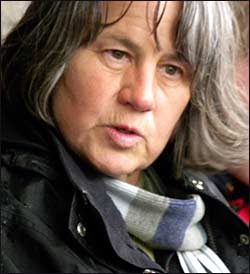
Rubble to Raised Beds
Ann Bettman’s strategy for the Courthouse Garden
By Rachel Foster
If you’ve driven lately past that messy bit of land just east of the new U.S. Courthouse, you’ll have noticed something going on. And if you’ve read your Eugene Weekly closely, you’ll know that it’s a new urban food garden. The brainchild of Judge Ann Aiken, whose chambers overlook this formerly desolate site, the project is masterminded by Ann Bettman, retired director of the UO’s Urban Farm, and her partner Dan Dingfield. (See EW, 3/18, for the scoop on all the players.) But how, exactly, did we get from rubble to raised beds? I met with Bettman recently to talk about this transformation.
 |
It began with leaves, about 90 truckloads of them, collected from the streets by the city of Eugene and dumped on the vacant lot in late December, at Bettman’s request. “I must have the leaves,” she said, “all the leaves I can get.” In February, a backhoe and trackhoe (courtesy of Staton Construction) went to work redistributing and leveling the consolidated fill that was on site, and then spread leaves on top of that, to a depth of two and a half feet.
I asked Bettman what method she followed in directing the construction of the raised beds that are appearing at the garden “in the wind shadow of the courthouse,” as she put it. “The beds are a combination of things I have been experimenting with over time,” she said, “but the strongest influence is Merry Bradley.” Bradley is director of FOOD for Lane County’s Grassroots Garden on Coburg Road, where she has developed an incredibly productive food garden.
“We didn’t have everything we needed on site at the same time, so we just got started with what we had,” Bettman said. That’s roughly 6-10 inches of the consolidated fill, then leaves and then topsoil. She had calculated that she needed 900 cubic yards of loam but was able to secure only 300 cubic yards, so she made do: “We’ve become very flexible,” she said. Volunteers with wheelbarrows laid the loam 12-14 inches deep on top of the leaves, in the form of beds prescribed in Bettman’s thoughtful plan.
Phil Carroll, who works with UO maintenance, told Bettman the UO had “a ton of compost,” and Lane County stepped up to transport it to the garden site. So six inches of compost went on top of the loam, plus chicken manure donated in 25 pound bags. Bettman reckons the combined leaves and loam have now settled to about a foot and a half. She hopes the leaves will inoculate the beds with soil microorganisms, but she’ll fertilize a little more heavily with organic fertilizer, just in case.
When I met with Bettman, there were two remaining areas still to be developed. “We are going to try different things,” she said, “so the garden will be a learning resource for the community.”
More leaves have been wheelbarrowed in to augment the paths between the finished beds. Next fall those leaves, by then partially broken down, will be piled on the beds and replaced with fresh ones, the way Bradley does it at Grassroots Garden. Same thing the next year. “You’ll have a good garden this year for the judge,” Bradley predicted (Aiken would like the garden to be in full swing by late June, when she presides over a national conference in Eugene). “Next year you’ll have a really good garden, and the year after that you’ll have a great garden.”
After five volunteer work parties, Bettman and her co-teacher Lorri Nelson planted blueberries (six kinds, donated by Fall Creek Nursery) on the first day of their university class. A day later, people from the judge’s reentry program planted strawberries, donated by Jackie Robertson, and artichoke and broccoli starts from Nick Routledge’s Transitions program. Alice Doyle at Log House Plants has since donated 60 flats of flower and vegetable starts. The garden is off to a great start. Go and see.
Saturdays are community workdays at the Courthouse Garden. Show up between 10 am and 1 pm. Donations of money, labor, tools and heavy equipment time are ongoing needs.